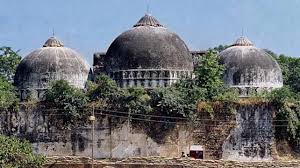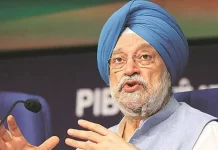The Muslim community and its political leaders are doing well by maintaining silence over the Babri Masjid-Ramjanmabhoomi dispute
Irfan Engineer siyasat.net news desk
A section of Hindu supremacist organizations are once again mobilizing to demand the construction of Ramjanmabhoomi temple (RJT) in Ayodhya on the spot where Babri Masjid once stood and was demolished on 6th December 1992. Provocative speeches are being made and threats are issued. Sentiments of Hindus are being aroused around the construction of Ramjanmabhoomi temple. Media too is playing the ball and faithfully publicising the claims of Hindu supremacist that sentiments of all Hindus are hurt unless a temple is forthwith constructed. The Hindu supremacists remember RJT as elections approach.
Most of the public speeches seeking to arouse the sentiments of Hindus around RJT accuse the Supreme Court of India to be insensitive to the feelings of Hindus and even discriminating against them. They argued that a terrorist, Yakub Memon, was given hearing at 3.00 am on 30th July 2015, as he was to be hanged till death the following morning the same day. Adjourning the matter would require stay on his hanging and not hearing his final plea would have left the court open to the charge of not doing justice. Their charge that Apex Court does not have time to hear the “issues of Hindus” is without any basis.
Besides comparing apples and oranges, their outbursts also amount to contempt of court as they are discourteous towards the court and seek to lower the dignity of the court. They are also interfering in the dispensation of justice by resorting to intimidation. Why is the Apex Court not proceeding for contempt of court suo moto against all those who made such provocative statements perhaps tells its own story.
The Hindu supremacists are deliberately twisting the facts about the issues involved in the Babri Masjid – RJT case. Basically the case pertains to title suit of 2.77 acres of land on which Babri Masjid once stood and was demolished on 6th December 1992. Who was the legal owner of the parcel of land in question and the structure on it legally? Through political mobilization other issues were piled on viz. whether the disputed site is believed by Hindus to be birth place of Lord Ram and whether the mosque was constructed after demolition of RJT under the orders of Mughal Emperor Babar.
The Hindu supremacists are converting the title suit into an issue of faith according to which Hindus believe the land parcel to be birth place of Lord Ram; and since they believe so, their faith should reign supreme and disregarding any other legal issues the parcel of land should be handed over to them for construction of RJT. They further argue that Muslims have not prayed in the Mosque since 1949 and therefore the place is not a mosque any more. Further, they argue that Muslims can pray anywhere and therefore it is not essential and integral part of their religion. Some even argue that since the Mosque was constructed after demolition of a temple, it was done so in violation of tenets of Islam and therefore it was never a mosque. Be as it may, it is for the Apex Court to do justice on the basis of laws as applicable in the land.
The dispute is not for temple or mosque anymore
Although the dispute appears to be between the Hindu community and the Muslim community, it is not so! That is what the Hindu supremacists want to turn the dispute into. If it becomes one between the two communities, then on the basis of sheer might of numbers and levers of power that the community elite control, the Hindu supremacists stand to win hands down! Construction of RJT has become a milestone in asserting ‘faith’ and power of the Hindu supremacists. All Hindus are not Ram bhaktas and all Ram bhaktas are not in favour of the RJT on the very spot where Babri Masjid was demolished.
Although the issue – whether Hindus believe that Lord Ram was born on the very spot where Babri Masjid once stood, was answered by the Allahabad High Court in affirmative, the Hon’ble court did not have any sufficient material to reach the conclusion. There was no referendum or even a fairly representative survey carried out to ascertain beliefs of the members of Hindu community on the issue. The constant mobilization by Hindu supremacist and the nature of media coverage may have coloured the judgement of the court. In the south of Vindhyas, the issue of RJT and place of birth of Lord Ram is of much less consequence that North. The slogging classes and castes are much less bothered as to where Lord Ram was born, although they have firm faith in Lord Ram. Dalit leader Chandrashekhar Azad has named himself “Ravan”.
Before the year 1985, the question, ‘where was Lord Ram born?’, would not have been answered with certainty by most Hindus, including those in Ayodhya, pointing to any precise spot. Overwhelming number of Hindus would have been clueless, except saying that the Lord was born in Ayodhya. Ayodhya city had more than 14 temples located in various places claiming to be on Ramjanmabhoomi which have now been demolished to make way for another one. The faith pertaining to precise spot on which Lord Ram was born has been constructed in late eighties using mobilization for political outcomes aided by mass media.
The plea of supremacy of faith over facts and law is not a religious project but a political agenda. For, to privilege faith of one section of populace sharing a particular religion over other faiths, and more importantly over demonstrable truths requires a theocratic state, not a democratic state which gives space to all religions, faiths and beliefs subject to certain reasonable restrictions in the interest of peace, harmony, equality, liberties and dignity of all individuals. The mobilization of gullible sections willing to subscribe to the faith being propounded by Hindu supremacists forcing the state to hand over the parcel of land based on their faith for construction of RJT is therefore a political mobilization to hammer nails in the coffin of democracy. More than construction of RJT, the Hindu supremacists are keen on dismantling democratic state which affords more or less equal space to all faiths subject to certain reasonable restrictions. That is why there was series of mobilization and show of strength by various Hindu supremacist organizations, including Vishwa Hindu Parishad, Hindu Mahasabha, Dharmasabha and Shiv Sena. Their target was the Supreme Court which they do not seem to trust, fearing that Supreme Court’s outcome might not be based on faith but law and justice. Their demand was that Parliament pass a legislation to hand the entire land on which Babri Masjid once stood for the construction of RJT. Construction of RJT on ruins of Babri Masjid is simultaneously laying foundation stone of Hindu Rashtra, a communal state that privileges the elite of Hindu community and relegates the rest who do not subscribe to Hindutva political ideology and its faith to second class citizens without any rights.
The conflict therefore is not between Hindu community and Muslim community, but between those who want India to be democratic, diverse, liberal respecting all faiths, including that of rationalists and atheists, dignity of all individuals and equality of all citizens on the one hand, and those who want India to be one homogenous society with state monitoring food and clothing and regimenting religion, state and community elders overlooking matrimonial alliances faith and truth is what the elite declare it to be so. That latter notion is against Hindu religion as propounded by great saints like Kabir, Ravi Das, Mirabai, Chokha Mela, Aakho, Narsi Mehta, Sree Naryana Guru, Basavanna, Swami Vivekananda, Guru Nanak, Buddha, and many other saints.
Muslims should leave resolution of the dispute regarding Babri Masjid-RJT to the Supreme Court and to those Hindus who follow the saints mentioned. It is more important to defend the Constitution and Constitutional idea of diverse, inclusive India where all citizens enjoy equal rights, liberties of thought, expression and conscience, where dignity of all citizens is upheld and there is social justice. The difficulty is that the religious leaders and political elite of the community also do not desire the idea of India which is democratic and respects the Constitution. They too give precedence their faith over Constitution, law, liberties and social justice. This was evident from the affidavit they filed in Supreme Court in support of triple talaq, when they deny equality to women on plea of right to follow their religious laws or Muslim Personal Law; when they demand ban on Salman Rushdie written book Satanic Verses; when they mobilized to oppose the Shahbano judgement that granted maintenance to a divorced Muslim woman under section 125 of the Indian Penal Code.
In fact the demand to open the locks of RJT for darshan and worship of Lord Ram and construction of grand RJT got tremendous boost after they forced the Rajiv Gandhi Government to bring in a law in Parliament to reverse the Shahbano judgement of the Supreme Court.
The Muslim community and its political leaders are doing well by maintaining silence over the Babri Masjid-Ramjanmabhoomi dispute. They are neither giving in under the pressure of mobilization by Hindu supremacists nor are they defiantly opposing construction of the RJT subjecting themselves to the judgment of the Supreme Court. The Hindu supremacist have succeeded only in getting some degenerate leaders of the community to do the bidding for them.
The Muslim community needs to focus on secular education as Sir Sayyid did in the late 19th century. Education would enable members of the community to be civil services and other important professions. Matured intellectual leadership of the community can come only from the educated class to steer them out of their social and educational backwardness.
The political leadership of the community needs to address itself to the issues of security and communal violence along with discrimination seeking justice and remedies through Constitutional mechanisms. In order to be able to do so, the leadership will have to build alliances with other marginalised classes who face similar discrimination, oppression and violence in their daily life. The alliance with other marginalized groups should not be opportunistic and only political power, but to seek political power to build robust democratic institutions that defend human rights of all citizens, to deepen democracy and democratic state that is accountable to its citizens. Muslim political leadership should apply itself to building structures of accountability and institutional mechanisms like Equal Opportunity Commission.
The political, intellectual and religious leadership of the community needs to apply itself to reforms in family laws that are within the framework of Islam as well as the Constitution. The Muslim political leaderships resists any reforms even though many Muslim countries have carried out reforms. Reforms should particularly ensure equality and equal status of women in the community in accordance with the Quranic spirit. Islamic laws and modern but still the community refuses to usher in reforms.
If these steps are debated within the community and followed, it would go a long way in weakening the Hindu supreamacist. More than Babri Masjid we need democratic India, educated India and India that embraces gender justice and diversity.



































